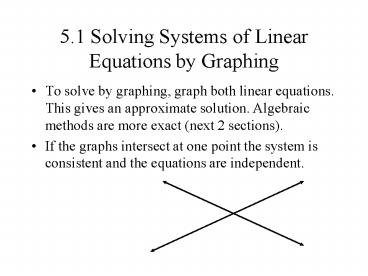5.1 Solving Systems of Linear Equations by Graphing
1 / 11
Title:
5.1 Solving Systems of Linear Equations by Graphing
Description:
5.1 Solving Systems of Linear Equations by Graphing To solve by graphing, graph both linear equations. This gives an approximate solution. Algebraic methods are more ... –
Number of Views:278
Avg rating:3.0/5.0
Title: 5.1 Solving Systems of Linear Equations by Graphing
1
5.1 Solving Systems of Linear Equations by
Graphing
- To solve by graphing, graph both linear
equations. This gives an approximate solution.
Algebraic methods are more exact (next 2
sections). - If the graphs intersect at one point the system
is consistent and the equations are independent.
2
5.1 Solving Systems of Linear Equations by
Graphing
- If the graphs are parallel lines, there is no
solution and the solution set is ?. The system is
inconsistent. - If the graphs represent the same line, there are
an infinite number of solutions. The equations
are dependent.
3
5.2 Solving Systems of Linear Equations by
Substitution
- Solving by substitution
- Solve for a variable
- Substitute for that variable in the other
equation - Solve this equation for the remaining variable
- Put your solution back into either of the
original equations to solve for the other
variable - Check your solution with the other equation
4
5.2 Solving Systems of Linear Equations by
Substitution
- ExampleFrom the first equation we get y2x-7,
so substituting into the second equation
5
5.2 Solving Systems of Linear Equations by
Substitution
- If when using substitution both variables drop
out and you get something like 106The system
inconsistent and there is no solution (parallel
lines) - If when using substitution both variables drop
out and you get something like 1010The system
dependent and every solution of one line is also
on the other (same lines)
6
5.3 Solving Systems of Linear Equations by the
Addition Method
- Solving systems of equations by the addition
method (a.k.a. elimination) - Write equations in standard form (variables line
up) - Multiply one of the equations to get coefficients
of one of the variables to be opposites - Add (or subtract) equations so that one
variable drops out - Solve for the remaining variable.
- Plug you solution back into one of the original
equations and solve for the other variable.
7
5.3 Solving Systems of Linear Equations by the
Addition Method
- Example
- Multiply the second equation by 3 to get
- Adding equations you get
8
5.3 Solving Systems of Linear Equations by the
Addition Method
- If when using elimination both variables drop out
and you get something like 106The system is
inconsistent and there is no solution (parallel
lines) - If when using elimination both variables drop out
and you get something like 1010The system is
dependent and every solution of one line is also
on the other (same lines)
9
5.4 Applications of Linear Systems of Equations
- Solving an applied problem by writing a system of
equations - Determine what you are to find assign variables
- Draw a diagram, figure or make a chart of
information. - Write the system of equations
- Solve the system using substitution or
elimination - Answer the question from the problem.
10
5.4 Applications of Linear Systems of Equations
- Mixture problem How many ounces of a 5 solution
must be added to a 20 solution to get 10 ounces
of 12.5 solution.Let x ounces of 5
solutionLet y ounces of 20 solution
11
5.4 Applications of Linear Systems of Equations
- Solution to mixture problem in 2 variables































